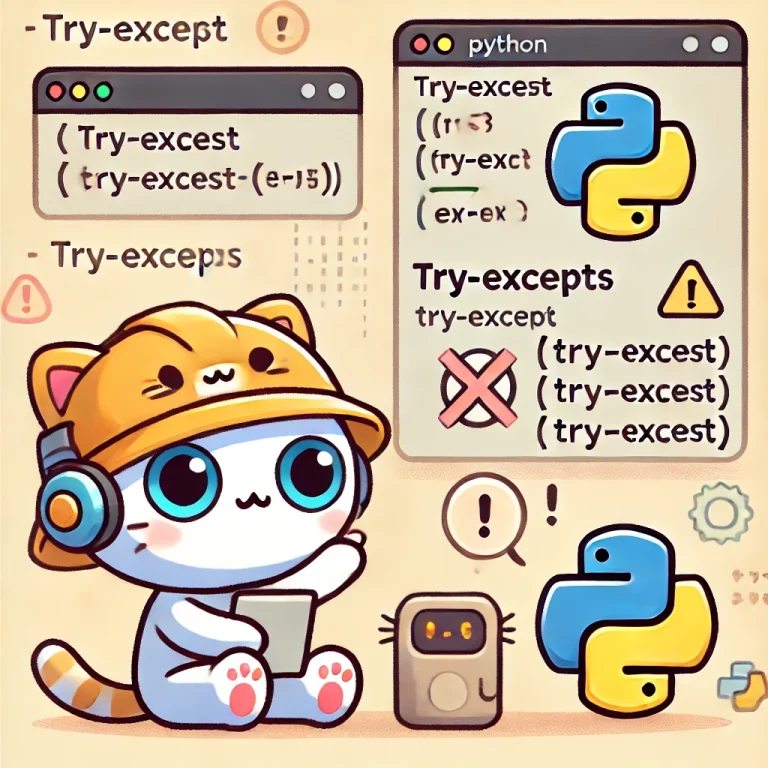エラー処理は、プログラムの堅牢性と信頼性を高めるために非常に重要な技術です。Pythonでは、try, except, else, finallyブロックを使用して、実行時に発生する可能性のあるエラーをキャッチし、適切に処理することができます。これにより、予期しないエラーが発生しても、プログラムが適切に対応し、ユーザーに対して適切なメッセージを提供することができます。
基本的なエラー処理
Pythonの基本的なエラー処理は、tryブロックでエラーが発生する可能性のあるコードを囲み、exceptブロックでそのエラーを処理します。elseブロックはエラーが発生しなかった場合に実行され、finallyブロックはエラーの有無にかかわらず必ず実行されます。
例題1: 基本的なエラー処理
まず、ゼロ除算エラーを処理する基本的な例を示します。
def divide(a, b):
try:
result = a / b
except ZeroDivisionError:
print("Error: Division by zero is not allowed.")
return None
else:
print("Division successful!")
return result
finally:
print("Execution completed.")
# 例題の実行
print(divide(10, 2)) # 出力: Division successful! 10.0 Execution completed.
print(divide(10, 0)) # 出力: Error: Division by zero is not allowed. None Execution completed.Division successful!
Execution completed.
5.0
Error: Division by zero is not allowed.
Execution completed.
Noneこのコードでは、divide関数内でゼロ除算が発生する可能性のある計算を行っています。ゼロ除算が発生した場合、except ZeroDivisionErrorブロックが実行され、エラーメッセージが表示されます。エラーが発生しなかった場合、elseブロックが実行され、計算結果が返されます。finallyブロックは常に実行され、実行完了メッセージを表示します。
例題2: 複数の例外を処理する
次に、複数の異なる種類の例外を処理する方法を示します。
def process_input(value):
try:
result = int(value)
result = 10 / result
except ValueError:
print("Error: Invalid input. Please enter a number.")
return None
except ZeroDivisionError:
print("Error: Division by zero is not allowed.")
return None
else:
print("Processing successful!")
return result
finally:
print("Execution completed.")
# 例題の実行
print(process_input("5")) # 出力: Processing successful! 2.0 Execution completed.
print(process_input("abc")) # 出力: Error: Invalid input. Please enter a number. None Execution completed.
print(process_input("0")) # 出力: Error: Division by zero is not allowed. None Execution completed.Processing successful!
Execution completed.
2.0
Error: Invalid input. Please enter a number.
Execution completed.
None
Error: Division by zero is not allowed.
Execution completed.
Noneこのコードでは、process_input関数内で文字列を整数に変換し、その後に10をその整数で割る計算を行っています。入力が無効な場合はValueErrorがキャッチされ、ゼロ除算が発生した場合はZeroDivisionErrorがキャッチされます。それぞれのエラーに対して適切なエラーメッセージが表示されます。
例題3: 独自の例外クラスを定義する
さらに、独自の例外クラスを定義して特定のエラーを処理する方法を示します。
class NegativeNumberError(Exception):
pass
def check_positive(value):
try:
if value < 0:
raise NegativeNumberError("Negative numbers are not allowed.")
result = 10 / value
except NegativeNumberError as e:
print(f"Error: {e}")
return None
except ZeroDivisionError:
print("Error: Division by zero is not allowed.")
return None
else:
print("Check successful!")
return result
finally:
print("Execution completed.")
# 例題の実行
print(check_positive(5)) # 出力: Check successful! 2.0 Execution completed.
print(check_positive(-3)) # 出力: Error: Negative numbers are not allowed. None Execution completed.
print(check_positive(0)) # 出力: Error: Division by zero is not allowed. None Execution completed.Check successful!
Execution completed.
2.0
Error: Negative numbers are not allowed.
Execution completed.
None
Error: Division by zero is not allowed.
Execution completed.
Noneこのコードでは、NegativeNumberErrorという独自の例外クラスを定義し、負の数が入力された場合にこの例外を発生させています。check_positive関数内でこの例外をキャッチし、適切なエラーメッセージを表示します。
結論
Pythonのエラー処理は、プログラムの堅牢性を高めるために非常に重要な技術です。エラー処理を適切に実装することで、科学技術分野でのデータ解析や計算アルゴリズムの実行中に発生する可能性のあるエラーに対して適切に対応でき、信頼性の高いプログラムを作成することができます。try, except, else, finallyの各ブロックを理解し、適切に使用することで、予期しないエラーに対する防御力を高めることができます。

